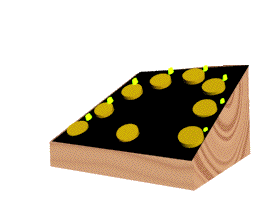Odd Man Out Test on:
[Wikipedia]
[Google]
[Amazon]
 The Odd-Man-Out Reaction Time test (OMO RT) is a test of reaction times that uses
The Odd-Man-Out Reaction Time test (OMO RT) is a test of reaction times that uses
 The Odd-Man-Out Reaction Time test (OMO RT) is a test of reaction times that uses
The Odd-Man-Out Reaction Time test (OMO RT) is a test of reaction times that uses Arthur Jensen
Arthur Robert Jensen (August 24, 1923 – October 22, 2012) was an American psychologist and writer. He was a professor of educational psychology at the University of California, Berkeley. Jensen was known for his work in psychometrics an ...
's testing apparatus, the Jensen box
The Jensen box was developed by University of California, Berkeley psychologist Arthur Jensen as an experimental apparatus for measuring choice reaction time (RT) and individual differences in intelligence.
Design and measurement
The standard ...
. The box is normally used for measuring choice reaction times in which the participant in the experiment is tested on their ability to recognize which of the eight lights of the Jensen box is illuminated, as quickly as possible. However, in the Odd Man Out Reaction Time test, three lights are illuminated in each trial. Two are close together and the other further apart; the individual being tested must identify this third light.
The Odd-Man-Out Reaction Time test correlates with " Intelligent Quotients (IQ) in the range of 0.30 to 0.60, a reliable and substantial effect." This correlation
In statistics, correlation or dependence is any statistical relationship, whether causal or not, between two random variables or bivariate data. Although in the broadest sense, "correlation" may indicate any type of association, in statisti ...
range is typically higher than the correlations to IQ in other reaction-time tests.
Experiments
In 1986, Frearson andHans Eysenck
Hans Jürgen Eysenck (; 4 March 1916 – 4 September 1997) was a German-born British psychologist who spent his professional career in Great Britain. He is best remembered for his work on intelligence and personality, although he worked on othe ...
conducted an experiment in which they assessed participants on various intelligence tests including Jensen's Choice Reaction Time , IQ, and a “new” Odd-Man-Out Reaction Time test. In their experiment, they found that the Odd-Man-Out Reaction Time test was capable of producing "measures that were reliable and correlate well with an individual's IQ."
An interesting result from the experiment was that there was no difference in the correlation between the Odd-Man-Out Reaction Time test and IQ when displays were presented in a more difficult manner. For example, a more difficult display of the Odd Man Out Reaction Time test would mean the difference in the distance between the odd man out and the two stimuli placed closer together was less notable (x000x00x being more difficult than xx0000x0). The expectation would be that the difficulty of a display would affect the correlation between Odd-Man-Out Reaction Time test and IQ. However, this was not the case. In addition, they discovered that the position of the pattern in the layout did not play a role in the reaction time.
In another experiment by Diascro and Brody (1994), the results showed that when the complexity of the Odd Man Out Reaction Time test was increased (by comparing more distances), the correlation between the individual's performance on the test and their intelligence (measured by an IQ test) was higher. They also found that the reaction times were longer and that individuals made mistakes more often with this more complex version of the Odd-Man-Out Reaction Time test.
Correlation with IQ tests
The Odd-Man-Out Reaction Time examination not only measures one's reaction time, but also one's ability to distinguish differences among the stimuli. More specifically, the odd man out task involves comparing the proportion of distances: the distance between the one light which is further away than the others, and the two lights that are closer together. Therefore, the higher correlation between the Odd Man Out Reaction Time test and IQ versus the Choice Reaction Time test and IQ could be potentially explained in that it is more complex because it tests an individual's ability to rapidly perceive differences in relationships in comparison to the Choice Reaction Time Test, which would be considered a clear discrimination task.Significance
The Odd-Man-Out Reaction Time Test is important to the study ofintelligence
Intelligence has been defined in many ways: the capacity for abstraction, logic, understanding, self-awareness, learning, emotional knowledge, reasoning, planning, creativity, critical thinking, and problem-solving. It can be described as the a ...
because it enables researchers to assess the speed of an individual's perception of relationships and difference among stimuli
A stimulus is something that causes a physiological response. It may refer to:
*Stimulation
** Stimulus (physiology), something external that influences an activity
**Stimulus (psychology), a concept in behaviorism and perception
*Stimulus (econom ...
. Furthermore, the Odd-Man-Out Test is an example of a more complex reaction time test, which has a higher correlation with IQ. The Odd-Man-Out Reaction Time test assesses two particular aspects of speed processing, "efficient sensory analysis which is measured by inspection time, and efficient decision making, which is measured by reaction time." The Odd-Man-Out Reaction Time test serves to examine an individual's speed of mental processing
The mind is the set of faculties responsible for all mental phenomena. Often the term is also identified with the phenomena themselves. These faculties include thought, imagination, memory, will, and sensation. They are responsible for various ...
, which is an important "component of the intelligence measured by IQ tests."
References
{{Reflist Intelligence tests